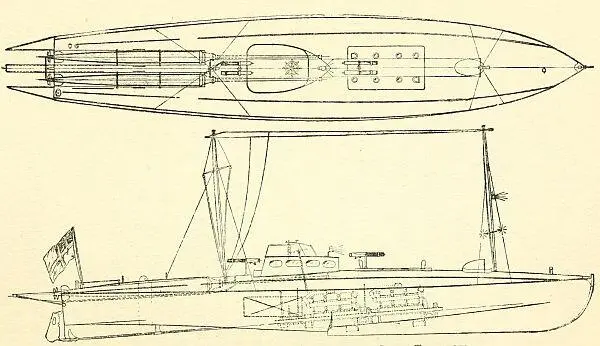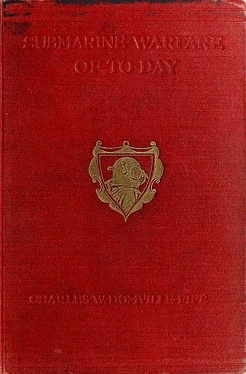
Plan of 55 feet Coastal Boat, carrying two 18-inch Torpedoes
CHAPTER I
The Task of the Allied Navies
The hour was that of the Allies’ greatest need—the last months of the year 1914. On that fateful 4th August the British navy was concentrated in the North Sea, and the chance for a surprise attack by the German fleet, or an invasion of England by the Kaiser’s armies, vanished for ever, and with this one chance went also all reasonable possibility of a crushing German victory.
Although during the years of bitter warfare which followed this silent coup de main the German fleet many times showed signs of awakening ambition, it did not, after Jutland, dare to thrust even its vanguard far into the open sea. Behind its forts, mines and submarines it waited, growing weaker with the dry-rot of inaction, for the chance that fickle Fortune might place a single unit of the Allied fleet within easy reach of its whole mailed-fist.
With a great and modern fleet—the second strongest in the world—awaiting its chance less than twenty hours’ steam from the coast of Great Britain, it quickly became evident that the old Mistress of the Seas would have to call upon her islanders to supply a “new navy” to scour the oceans while her main battle squadrons waited and watched for the second Trafalgar.
Faced, then, with the problem of a long blockade, a powerful fleet in readiness to strike at any weak or unduly exposed point of land or squadron, and with similar problems on a decreasing scale imposed by Austria in the Adriatic and by Turkey behind the Dardanelles, the work of the main battle fleets became well defined by the commonest laws of naval strategy.
All this without taking into account the widespread menace of submarines and mines, and, in the earlier stages of the war, the rounding-up of detached enemy squadrons, such as that under Von Spee in South American waters, and the protection of the transport and food ships from raiders like the Wolfe and the Moewe .
The German High Command realised this as quickly as that of the Allies. Their oversea commerce was strangled within a few days of the Declaration of War with Great Britain, and their fleet was confined to harbour, with the exception of occasional operations against Russia in the Baltic. From the German standpoint the naval problem resolved itself into one of how best to strike at the lines of communication of the Allies, paying special attention, first, to the transport of troops, and, second, to England’s food supply. As they alone knew to what extent they would violate the laws of war and of humanity, it became apparent that the submarine and the mine were the only possible weapons which could be used for this purpose in face of the superior fleets of the Allies. But the number of these weapons was strictly limited compared with the immense shipping resources at the command of the Western Powers, so one submarine must do the work of many, and an effort was made to accomplish this by a reign of sea terrorism and inhuman conduct unparalleled in the history of the world. It opened with the sinking of the Lusitania .
The Allies had secured and maintained the command of the sea, and all that it implies , but to do this with the certainty of correct strategy they had to dedicate almost their entire battle fleet to the purpose for which battle fleets have always been intended—the checkmating or annihilation of the opposing navy.
There came a second problem, however, one entirely new to sea warfare, and unconsidered or provided against in its strategic and tactical entirety because hitherto deemed too inhuman for modern war. This was the ruthless use of armed submarines against unarmed passenger and merchant ships, and the scattering broadcast over the seas, regardless of the lives and property of neutrals, of thousands of explosive mines.
The type of ship constructed exclusively for open sea warfare against surface adversaries was not the best answer to the submarine. The blockading of the hostile surface fleet did not prevent, or even greatly hinder, the free passage of submarine flotillas, and the building by Germany of under-water mine-layers enabled fields of these weapons to be laid anywhere within the carrier’s radius of action.
In this way the second, or submarine, phase of the naval war opened, and it was to supplement the comparatively few fast destroyers and other suitable ships which could be spared from the main fleets that the “new navy” was formed.
The area of the North Sea alone exceeds 140,000 square miles, and when the whole vast stretch of water encompassed by what was known as the radius of action of hostile submarines, from their bases on the German, Belgian, Austrian, Turkish and Bulgarian coasts, had to be considered as a possible zone of operations for German and Austrian under-water flotillas, much of the water surface of the world was included. Likewise the network of sea communications on which the Allies depended for the maintenance of essential transport and communication comprised the pathways of the seven seas. To patrol all these routes adequately, and to guard the food and troop ships, hastening in large numbers to the aid of the Motherland from the most distant corners of the earth; to protect the 1500 miles sea frontier of the British Isles; to give timely aid to sinking or hard-pressed units of the mercantile fleet; to hound the submarine from the under-seas and to sweep clear, almost weekly, several thousand square miles of sea, from Belle Isle to Cape Town and the Orkneys to Colombo, required ships, not in tens, but in thousands. To find these in an incredibly short space of time became the primary naval need of the moment.
Who that lived through those days will forget the struggle to supply ships and guns? The searching of every harbour for craft, from motor boats to old-time sailing-ships, and from fishing craft to liners. The scouring of the Dominions and Colonies. How blessed was their aid! Help, generous and spontaneous, came from all quarters, including the most unexpected. Over five hundred fast patrol boats, or motor launches, in less than twelve months from Canada and America. Guns from Japan. Coasting steamers from India, Australia, New Zealand and South Africa. Seaplanes from the Crown Colonies. Rifles from Canada. Machine guns from the United States. Ambulances from English and Colonial women’s leagues. In fact, contributions to the “new navy” from all corners of the earth.
To patrol the coasts of Britain alone, and to keep its harbours and coastal trade routes clear of mines, needed over 3500 ships, with at least an equal number of guns, 30,000 rifles and revolvers, and millions of shells.
In addition to this huge fleet other smaller squadrons were required for the Mediterranean, the Suez Canal and Red Sea, the East and West Indies, the coasts of the Dominions and Colonies, and for the Russian lines of communication in the White Sea. For these oversea bases just under 1000 ships were required, exclusive of those locally supplied by the Dominions and Colonies themselves.
All this without considering the main battle fleets or, in fact, any portion of the regular navy, and the ships required for the transport of food, troops and munitions of war, together with their escorts. Some idea of the numbers engaged in keeping the Allies supplied with the diverse necessities of life and war may be gathered from the fact that the average sailings in and out of the harbours of the United Kingdom alone during the four years of war amounted to over 1200 a week.
The immense fleet forming the new navy was not homogeneous in design, power, appearance or, in fact, in anything except the spirit of the personnel and the flag beneath which they fought—and alas! nearly 4000 died. The squadrons, or units, as they were called, consisted of fine steam yachts, liners from the ocean trade routes, sturdy sea tramps, deep-sea trawlers, oilers, colliers, drifters, paddle steamers, and the more uniform and specially built fighting sloops, whalers, motor launches and coastal motor boats. The latter type of craft was aided by its great speed, nearly fifty miles an hour; but more about these ships and their curious armament later.
Читать дальше













